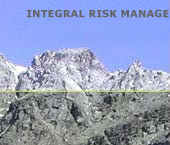| |
Population increase, natural resource demands, and the desire to experience recreation in pristine environments of high natural beauty lead to expansion of human activity into uninhabited mountain regions. Such regions are naturally subject to elevated morphodynamic activity characterized by high rates of erosion, transport, and deposition of water and (an-) organic matter. Owing to high relief and slope steepness, landslides, i.e. the downslope (and outward) movement of soil, debris, and rock materials under the influence of gravity, are often the dominant erosional agent. Under the term Extremely Rapid Mass Movements the following landslide and landslide-related processes are subsumed:
Debris flow is a motion of poorly sorted debris inside a slurry-like watery matrix, which may support buoyant meter-sized boulders on the surface of the debris flow. Debris flows are phenomena of massive sediment transport in steep mountain streams, where motion of the granular phase is gravity-induced.
|
|
Rock avalanching is the extremely rapid (>30 m/s), flow-like movement of large volumes (>106 m3) of rock being increasingly fragmented in the process.
Snow avalanching is the rapid down-slope displacement of snow masses. Though in many regions clearly a seasonal phenomenon, the damage from snow avalanches is comparable to that from debris flows.
These extremely rapid mass movement processes pose varying degrees of risk to land use, infrastructure, and personal security in many mountainous regions and should therefore be quantified using a framework of Integral Risk Management .
>> Home |

